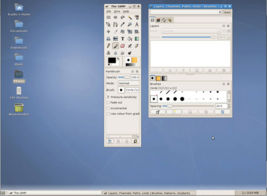Difference between revisions of "System Software"
| (24 intermediate revisions by one other user not shown) | |||
| Line 1: | Line 1: | ||
{{1260Chapter|Introduction= | {{1260Chapter|Introduction= | ||
| − | |||
| − | + | [[Operating Systems | Operating systems]] are the most common type of system software. Since many operating systems are bundled with [[Application Software | application software]], there is some confusion between the two. Operating systems run behind the scene and manage your computer’s resources and [[Hardware | hardware]].<ref>http://en.wikipedia.org/wiki/System_software - 2008</ref> Application software requires system software, such as an operating system, in order to [[Roles of the Operating System | talk to the hardware]]. Microsoft [[Windows |Windows]] and [[Mac | Apple’s OS X]] are the most widely used operating systems, but are not the only ones. There are also [[Unix and Linux | UNIX and Linux]], which are widely used in everything from [http://en.wikipedia.org/wiki/Embedded_system household appliances] to [[Supercomputer |supercomputers]]. | |
| − | + | ||
| − | + | ||
| − | + | At home, you are most likely using some version of Windows or Mac, and whether you know it or not, you are using UNIX and Linux. In fact you are using UNIX right now, this Wiki is located on the webmail UNIX [http://en.wikipedia.org/wiki/Server_(computing) server] on campus. You will encounter all four operating systems around campus. Windows is widely available in most of the open area computer labs. Macs are also used in the Math, Statistics and Engineering department. UNIX is used when uploading a web page on the campus servers. A few Linux and UNIX desktop computers can be found around campus for student use, but UNIX and Linux play a major role for many behind the scene functions at the U of M. | |
| − | + | |Image= | |
| − | + | [[Image:OperatingSystemExample.jpg|float|267px]] | |
| − | + | <BR> | |
| − | < | + | Taken from http://www.flickr.com/photos/daniello/565304023/ |
| − | + | ||
| − | + | ||
}} | }} | ||
| Line 41: | Line 36: | ||
====[[Is it still a Mac if it uses an Intel chip?]]==== | ====[[Is it still a Mac if it uses an Intel chip?]]==== | ||
====[[What OS is in Mac's iPhone? RIM's BlackBerry?]]==== | ====[[What OS is in Mac's iPhone? RIM's BlackBerry?]]==== | ||
| + | |||
| + | |||
| + | ==References== | ||
| + | <references/> | ||
| + | |||
| + | <br/> | ||
| + | <table width = 100%, style="font-size:130%"> | ||
| + | <tr> | ||
| + | <td align = left>'''Chapter 1: '''[[Application Software]]</td> | ||
| + | <td align = left>[[COMP1260 | Table of Contents]] </td> | ||
| + | <td align = right>'''Chapter 3: '''[[Hardware]]</td> | ||
| + | </tr> | ||
| + | </table> | ||
Latest revision as of 19:23, 1 December 2009
|
Chapter IntroductionOperating systems are the most common type of system software. Since many operating systems are bundled with application software, there is some confusion between the two. Operating systems run behind the scene and manage your computer’s resources and hardware.[1] Application software requires system software, such as an operating system, in order to talk to the hardware. Microsoft Windows and Apple’s OS X are the most widely used operating systems, but are not the only ones. There are also UNIX and Linux, which are widely used in everything from household appliances to supercomputers. At home, you are most likely using some version of Windows or Mac, and whether you know it or not, you are using UNIX and Linux. In fact you are using UNIX right now, this Wiki is located on the webmail UNIX server on campus. You will encounter all four operating systems around campus. Windows is widely available in most of the open area computer labs. Macs are also used in the Math, Statistics and Engineering department. UNIX is used when uploading a web page on the campus servers. A few Linux and UNIX desktop computers can be found around campus for student use, but UNIX and Linux play a major role for many behind the scene functions at the U of M.
|
|||
Operating Systems
What is an Operating System?
Roles of the Operating System
History of Operating Systems
Windows
Mac
Unix and Linux
Utility Programs
Utility Programs
File Management Software
File Management Software
Technology Matters!
What is Open Source Software?
Is it still a Mac if it uses an Intel chip?
What OS is in Mac's iPhone? RIM's BlackBerry?
References
| Chapter 1: Application Software | Table of Contents | Chapter 3: Hardware |
